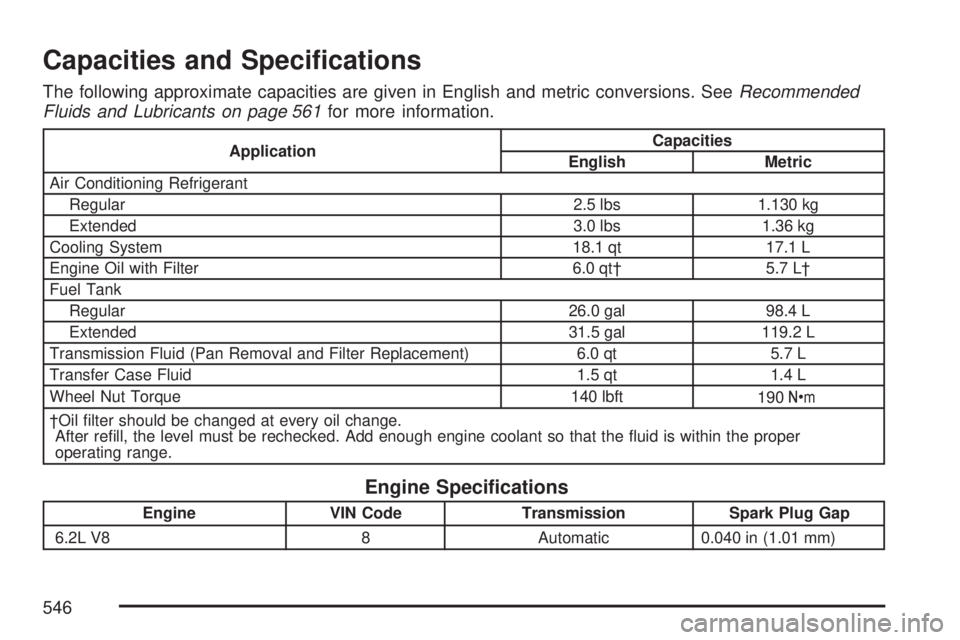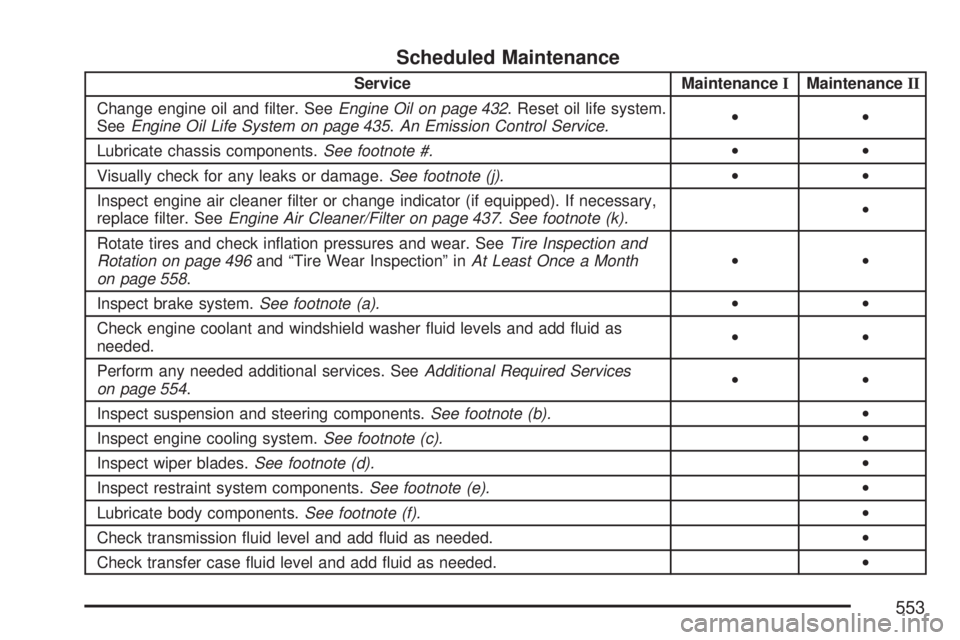engine coolant GMC YUKON 2007 Owner's Guide
[x] Cancel search | Manufacturer: GMC, Model Year: 2007, Model line: YUKON, Model: GMC YUKON 2007Pages: 608, PDF Size: 3.06 MB
Page 452 of 608

The coolant level should be at or above the
FULL COLD mark. If it is not, you may have
a leak at the pressure cap or in the radiator
hoses, heater hoses, radiator, water pump, or
somewhere else in the cooling system.
{CAUTION:
Heater and radiator hoses, and other
engine parts, can be very hot. Do not
touch them. If you do, you can be burned.
Do not run the engine if there is a leak.
If you run the engine, it could lose all
coolant. That could cause an engine �re,
and you could be burned. Get any leak
�xed before you drive the vehicle.
452
Page 453 of 608

Notice:Engine damage from running your
engine without coolant is not covered by your
warranty. SeeOverheated Engine Protection
Operating Mode on page 450for information on
driving to a safe place in an emergency.
Notice:Using coolant other than DEX-COOL
®
may cause premature engine, heater core or
radiator corrosion. In addition, the engine
coolant may require changing sooner, at
30,000 miles (50 000 km) or 24 months,
whichever occurs �rst. Any repairs would not
be covered by your warranty. Always use
DEX-COOL
®(silicate-free) coolant in your
vehicle.
How to Add Coolant to the Coolant
Surge Tank
If you have not found a problem yet, check to see
if coolant is visible in the surge tank. If coolant
is visible but the coolant level is not at or above
the FULL COLD mark, add a 50/50 mixture
of clean, drinkable water and DEX-COOL
®coolant
at the coolant surge tank, but be sure the
cooling system, including the coolant surge tank
pressure cap, is cool before you do it. SeeEngine
Coolant on page 445for more information.
453
Page 454 of 608

If no coolant is visible in the surge tank, add
coolant as follows:
{CAUTION:
Steam and scalding liquids from a hot
cooling system can blow out and burn
you badly. They are under pressure, and if
you turn the radiator pressure cap — even
a little — they can come out at high
speed. Never turn the cap when the
cooling system, including the radiator
pressure cap, is hot. Wait for the cooling
system and radiator pressure cap to cool
if you ever have to turn the pressure cap.
{CAUTION:
Adding only plain water to your cooling
system can be dangerous. Plain water, or
some other liquid such as alcohol, can
boil before the proper coolant mixture will.
Your vehicle’s coolant warning system is
set for the proper coolant mixture. With
plain water or the wrong mixture, your
engine could get too hot but you would
not get the overheat warning. Your engine
could catch �re and you or others could
be burned. Use a 50/50 mixture of clean,
drinkable water and DEX-COOL
®coolant.
Notice:In cold weather, water can freeze and
crack the engine, radiator, heater core and
other parts. Use the recommended coolant and
the proper coolant mixture.
454
Page 455 of 608

{CAUTION:
You can be burned if you spill coolant
on hot engine parts. Coolant contains
ethylene glycol and it will burn if the
engine parts are hot enough. Do not spill
coolant on a hot engine.
1. You can remove the
coolant surge tank
pressure cap
when the cooling
system, including
the coolant
surge tank pressure
cap and upper
radiator hose, is no
longer hot.
Remove the coolant surge tank pressure
cap by slowly turning the pressure cap
counterclockwise about one full turn. If you
hear a hiss, wait for that to stop. A hiss means
there is still some pressure left.2. Then keep turning the pressure cap slowly,
and remove it.
3. Fill the coolant surge tank with the proper
mixture, to the FULL COLD mark.
455
Page 456 of 608

4. With the coolant surge tank pressure cap off,
start the engine and let it run until you can
feel the upper radiator hose getting hot. Watch
out for the engine cooling fan.
By this time, the coolant level inside the
coolant surge tank may be lower. If the level is
lower, add more of the proper mixture to the
coolant surge tank until the level reaches
the FULL COLD mark.5. Then replace the pressure cap. Be sure the
pressure cap is hand-tight and fully seated.
6. Verify coolant level after engine is shut off
and the coolant is cold. If necessary, repeat
coolant �ll procedure steps 1 through 6.
Engine Fan Noise
Your vehicle has electric cooling fans, you may
hear the fans spinning at low speed during
most everyday driving. The fans may turn off if no
cooling is required. Under heavy vehicle loading,
trailer towing, and/or high outside temperatures, or
if you are operating your air conditioning system,
the fans may change to high speed and you
may hear an increase in fan noise. This is normal
and indicates that the cooling system is
functioning properly. The fans will change to low
speed when additional cooling is no longer
required.
456
Page 458 of 608

Windshield Washer Fluid
What to Use
When you need windshield washer �uid, be sure to
read the manufacturer’s instructions before use. If
you will be operating your vehicle in an area where
the temperature may fall below freezing, use a �uid
that has sufficient protection against freezing.
Adding Washer Fluid
Your vehicle has a message that comes on when
the washer �uid is low. The message is
displayed for 15 seconds at the start of each
ignition cycle. When the CHECK WASHER FLUID
message is displayed, you will need to add
washer �uid to the windshield washer �uid
reservoir. SeeDIC Warnings and Messages on
page 252for more information.
Open the cap with the
washer symbol on it.
Add washer �uid
until the tank is full. See
Engine Compartment
Overview on page 430
for reservoir location.Notice:
When using concentrated washer �uid,
follow the manufacturer’s instructions
for adding water.
Do not mix water with ready-to-use washer
�uid. Water can cause the solution to
freeze and damage your washer �uid tank
and other parts of the washer system.
Also, water does not clean as well
as washer �uid.
Fill your washer �uid tank only
three-quarters full when it is very cold.
This allows for expansion if freezing
occurs, which could damage the tank if it
is completely full.
Do not use engine coolant (antifreeze) in
your windshield washer. It can damage
your washer system and paint.
458
Page 546 of 608

Capacities and Speci�cations
The following approximate capacities are given in English and metric conversions. SeeRecommended
Fluids and Lubricants on page 561for more information.
ApplicationCapacities
English Metric
Air Conditioning Refrigerant
Regular 2.5 lbs 1.130 kg
Extended 3.0 lbs 1.36 kg
Cooling System 18.1 qt 17.1 L
Engine Oil with Filter 6.0 qt† 5.7 L†
Fuel Tank
Regular 26.0 gal 98.4 L
Extended 31.5 gal 119.2 L
Transmission Fluid (Pan Removal and Filter Replacement) 6.0 qt 5.7 L
Transfer Case Fluid 1.5 qt 1.4 L
Wheel Nut Torque 140 lbft
190Y
†Oil �lter should be changed at every oil change.
After re�ll, the level must be rechecked. Add enough engine coolant so that the �uid is within the proper
operating range.
Engine Speci�cations
Engine VIN Code Transmission Spark Plug Gap
6.2L V8 8 Automatic 0.040 in (1.01 mm)
546
Page 553 of 608

Scheduled Maintenance
Service MaintenanceIMaintenanceII
Change engine oil and �lter. SeeEngine Oil on page 432. Reset oil life system.
SeeEngine Oil Life System on page 435.An Emission Control Service.••
Lubricate chassis components.See footnote #.••
Visually check for any leaks or damage.See footnote (j).••
Inspect engine air cleaner �lter or change indicator (if equipped). If necessary,
replace �lter. SeeEngine Air Cleaner/Filter on page 437.See footnote (k).•
Rotate tires and check in�ation pressures and wear. SeeTire Inspection and
Rotation on page 496and “Tire Wear Inspection” inAt Least Once a Month
on page 558.••
Inspect brake system.See footnote (a).••
Check engine coolant and windshield washer �uid levels and add �uid as
needed.••
Perform any needed additional services. SeeAdditional Required Services
on page 554.••
Inspect suspension and steering components.See footnote (b).•
Inspect engine cooling system.See footnote (c).•
Inspect wiper blades.See footnote (d).•
Inspect restraint system components.See footnote (e).•
Lubricate body components.See footnote (f).•
Check transmission �uid level and add �uid as needed.•
Check transfer case �uid level and add �uid as needed.•
553
Page 557 of 608

(g)Inspect system. Check all fuel and vapor
lines and hoses for proper hook-up, routing, and
condition. Check that the purge valve works
properly, if equipped. Replace as needed.
(h)Change automatic transmission �uid and �lter
if the vehicle is mainly driven under one or
more of these conditions:
�In heavy city traffic where the outside
temperature regularly reaches 90°F (32°C)
or higher.
�In hilly or mountainous terrain.
�When doing frequent trailer towing.
�Uses such as found in taxi, police, or delivery
service.
(i)Drain, �ush, and re�ll cooling system. This
service can be complex; you should have
your dealer perform this service. See Engine
Coolant on page 445 for what to use. Inspect
hoses. Clean radiator, condenser, pressure
cap, and �ller neck. Pressure test the cooling
system and pressure cap.(j)A �uid loss in any vehicle system could indicate
a problem. Have the system inspected and
repaired and the �uid level checked. Add �uid if
needed.
(k)If you drive regularly under dusty conditions,
inspect the �lter at each engine oil change.
(l)Visually inspect belt for fraying, excessive
cracks, or obvious damage. Replace belt if
necessary.
(m)Check vent hose at transfer case for kinks
and proper installation.
Owner Checks and Services
These owner checks and services should be
performed at the intervals speci�ed to help
ensure the safety, dependability, and emission
control performance of your vehicle. Your
GM Goodwrench
®dealer can assist you with
these checks and services.
Be sure any necessary repairs are completed at
once. Whenever any �uids or lubricants are added
to your vehicle, make sure they are the proper
ones, as shown inRecommended Fluids and
Lubricants on page 561.
557
Page 558 of 608

At Each Fuel Fill
It is important to perform these underhood checks
at each fuel �ll.
Engine Oil Level Check
Check the engine oil level and add the proper
oil if necessary. SeeEngine Oil on page 432for
further details.
Notice:It is important to check your oil
regularly and keep it at the proper level. Failure
to keep your engine oil at the proper level
can cause damage to your engine not covered
by your warranty.
Engine Coolant Level Check
Check the engine coolant level and add
DEX-COOL®coolant mixture if necessary. See
Engine Coolant on page 445for further details.
Windshield Washer Fluid Level Check
Check the windshield washer �uid level in
the windshield washer �uid reservoir and add the
proper �uid if necessary.
At Least Once a Month
Tire In�ation Check
Visually inspect your vehicle’s tires and make sure
they are in�ated to the correct pressures. Do
not forget to check the spare tire. SeeTires on
page 480for further details. Check to make
sure the spare tire is stored securely. See
Changing a Flat Tire on page 506.
Tire Wear Inspection
Tire rotation may be required for high mileage
highway drivers prior to the Engine Oil Life System
service noti�cation. Check the tires for wear
and, if necessary, rotate the tires. SeeTire
Inspection and Rotation on page 496.
558